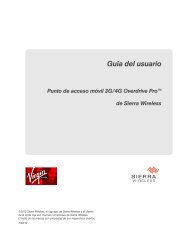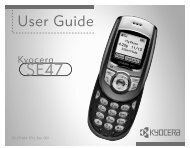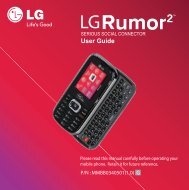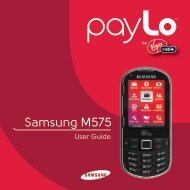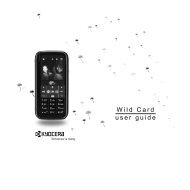Untitled - Virgin Mobile
Untitled - Virgin Mobile
Untitled - Virgin Mobile
Create successful ePaper yourself
Turn your PDF publications into a flip-book with our unique Google optimized e-Paper software.
Safety<br />
Safety<br />
SAR. The SAR is a measure of the rate of<br />
absorption of RF energy by the human<br />
body expressed in units of watts per<br />
kilogram (W/kg). The FCC requires wireless<br />
phones to comply with a safety limit of 1.6<br />
watts per kilogram (1.6 W/kg). The FCC<br />
exposure limit incorporates a substantial<br />
margin of safety to give additional<br />
protection to the public and to account for<br />
any variations in measurements.<br />
Tests for SAR are conducted using<br />
standard operating positions specified by<br />
the FCC with the phone transmitting at its<br />
highest certified power level in all tested<br />
frequency bands. Although SAR is<br />
determined at the highest certified power<br />
level, the actual SAR level of the phone<br />
while operating can be well below the<br />
maximum value. Because the phone is<br />
designed to operate at multiple power<br />
levels to use only the power required to<br />
reach the network, in general, the closer<br />
you are to a wireless base station antenna,<br />
the lower the power output.<br />
Before a phone model is available for sale<br />
to the public, it must be tested and<br />
certified to the FCC that it does not<br />
exceed the limit established by the<br />
government-adopted requirement for safe<br />
exposure. The tests are performed in<br />
positions and locations (e.g., at the ear<br />
and worn on the body) as required by the<br />
FCC for each model.<br />
This device was tested for typical bodyworn<br />
operations with the back of the<br />
phone kept 0.79 inches (2.0 cm) between<br />
the user’s body and the back of the phone.<br />
To comply with FCC RF exposure<br />
requirements, a minimum separation<br />
distance of 0.79 inches (2.0 cm) must be<br />
maintained between the user's body and<br />
the back of the phone. Third-party beltclips,<br />
holsters, and similar accessories<br />
containing metallic components should not<br />
be used. Body-worn accessories that<br />
cannot maintain 0.79 inches (2.0 cm)<br />
separation distance between the user's<br />
body and the back of the phone, and have<br />
not been tested for typical body-worn<br />
operations may not comply with FCC RF<br />
exposure limits and should be avoided.<br />
The FCC has granted an Equipment<br />
90



